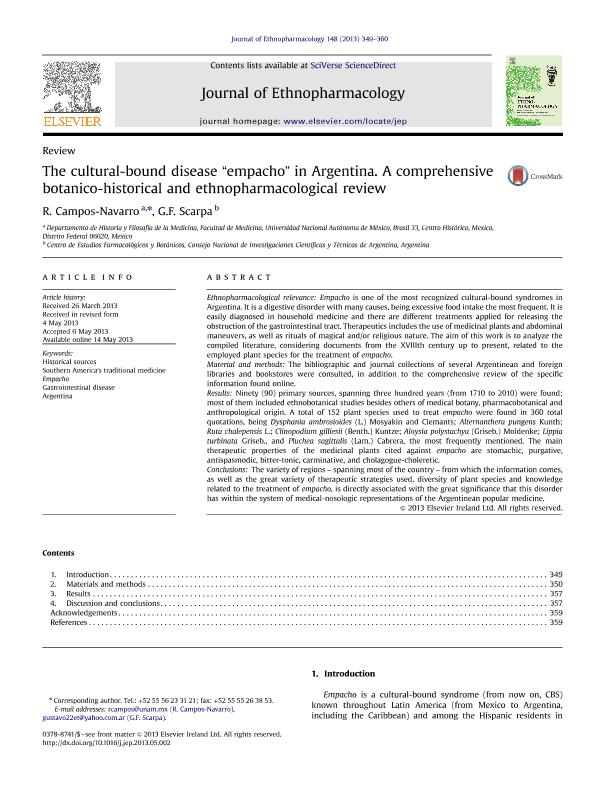Mostrar el registro sencillo del ítem
dc.contributor.author
Campos Navarro, R.
dc.contributor.author
Scarpa, Gustavo Fabian

dc.date.available
2017-01-12T20:34:27Z
dc.date.issued
2013-07
dc.identifier.citation
Campos Navarro, R.; Scarpa, Gustavo Fabian; The cultural-bound disease 'empacho' in Argentina. A comprehensive botanico-historical and ethnopharmacological review; Elsevier Ireland; Journal Of Ethnopharmacology; 148; 2; 7-2013; 349-360
dc.identifier.issn
0378-8741
dc.identifier.uri
http://hdl.handle.net/11336/11244
dc.description.abstract
Ethnopharmacological relevance
Empacho is one of the most recognized cultural-bound syndromes in Argentina. It is a digestive disorder with many causes, being excessive food intake the most frequent. It is easily diagnosed in household medicine and there are different treatments applied for releasing the obstruction of the gastrointestinal tract. Therapeutics includes the use of medicinal plants and abdominal maneuvers, as well as rituals of magical and/or religious nature. The aim of this work is to analyze the compiled literature, considering documents from the XVIIIth century up to present, related to the employed plant species for the treatment of empacho.
Material and methods
The bibliographic and journal collections of several Argentinean and foreign libraries and bookstores were consulted, in addition to the comprehensive review of the specific information found online.
Results
Ninety (90) primary sources, spanning three hundred years (from 1710 to 2010) were found; most of them included ethnobotanical studies besides others of medical botany, pharmacobotanical and anthropological origin. A total of 152 plant species used to treat empacho were found in 360 total quotations, being Dysphania ambrosioides (L.) Mosyakin and Clemants; Alternanthera pungens Kunth; Ruta chalepensis L.; Clinopodium gilliesii (Benth.) Kuntze; Aloysia polystachya (Griseb.) Moldenke; Lippia turbinata Griseb., and Pluchea sagittalis (Lam.) Cabrera, the most frequently mentioned. The main therapeutic properties of the medicinal plants cited against empacho are stomachic, purgative, antispasmodic, bitter-tonic, carminative, and cholagogue-choleretic.
Conclusions
The variety of regions – spanning most of the country – from which the information comes, as well as the great variety of therapeutic strategies used, diversity of plant species and knowledge related to the treatment of empacho, is directly associated with the great significance that this disorder has within the system of medical-nosologic representations of the Argentinean popular medicine.
dc.format
application/pdf
dc.language.iso
eng
dc.publisher
Elsevier Ireland

dc.rights
info:eu-repo/semantics/openAccess
dc.rights.uri
https://creativecommons.org/licenses/by-nc-nd/2.5/ar/
dc.subject
Empacho
dc.subject
Etnofarmacobotánica
dc.subject
Etnomedicina Argentina
dc.subject
Etnobotánica Médica
dc.subject.classification
Otras Humanidades

dc.subject.classification
Otras Humanidades

dc.subject.classification
HUMANIDADES

dc.title
The cultural-bound disease 'empacho' in Argentina. A comprehensive botanico-historical and ethnopharmacological review
dc.type
info:eu-repo/semantics/article
dc.type
info:ar-repo/semantics/artículo
dc.type
info:eu-repo/semantics/publishedVersion
dc.date.updated
2016-11-22T21:10:15Z
dc.journal.volume
148
dc.journal.number
2
dc.journal.pagination
349-360
dc.journal.pais
Irlanda

dc.journal.ciudad
Amsterdam
dc.description.fil
Fil: Campos Navarro, R.. Universidad Nacional Autónoma de México. Facultad de Medicina; México
dc.description.fil
Fil: Scarpa, Gustavo Fabian. Consejo Nacional de Investigaciones Científicas y Técnicas. Oficina de Coordinación Administrativa Houssay. Centro de Estudios Farmacológicos y Botánicos; Argentina
dc.journal.title
Journal Of Ethnopharmacology

dc.relation.alternativeid
info:eu-repo/semantics/altIdentifier/url/http://www.sciencedirect.com/science/article/pii/S0378874113003310
dc.relation.alternativeid
info:eu-repo/semantics/altIdentifier/doi/http://dx.doi.org/10.1016/j.jep.2013.05.002
Archivos asociados
